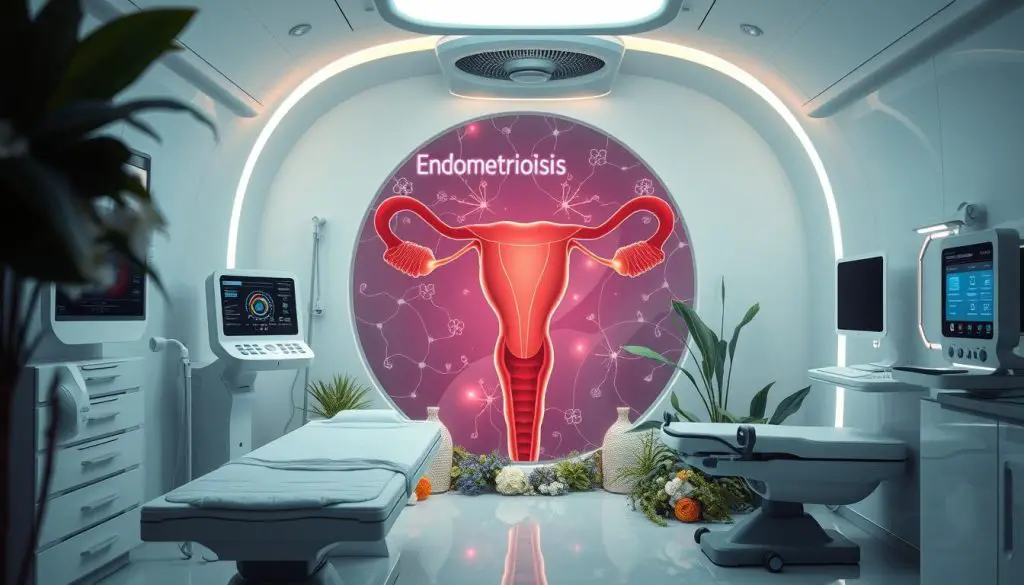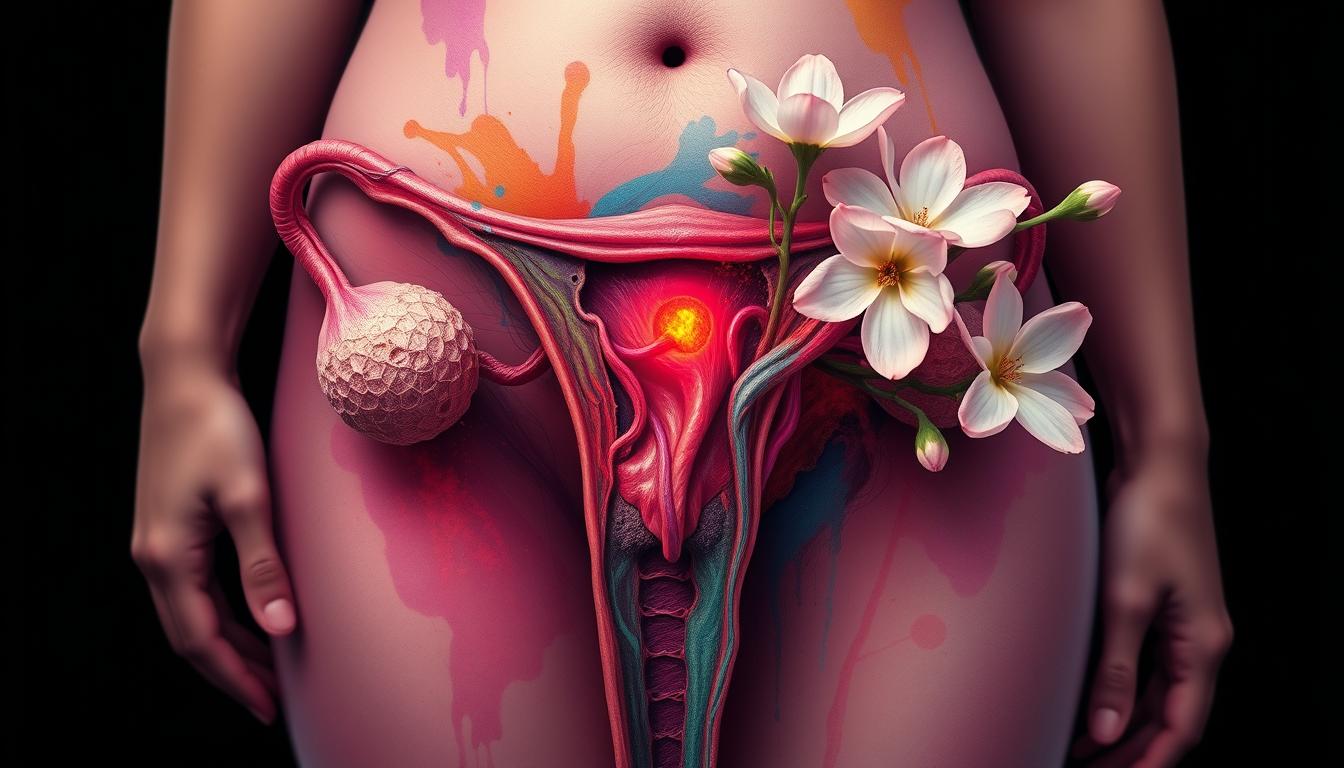Do you dread your monthly cycle because of the severe cramps and pain? You might be among the 10% of women with endometriosis. This condition makes the tissue inside the uterus grow outside, leading to intense pain during periods. But what causes this pain, and how can you ease it?
Endometriosis happens when tissue inside the uterus grows outside. This tissue builds up, breaks down, and bleeds during your period. But it can’t leave the body, causing inflammation and scarring.
This leads to severe pelvic pain, often worse during menstruation. The pain from menstrual cramps can be so bad it affects your daily life, work, and overall happiness.
What is Endometriosis?
Endometriosis is a chronic condition that affects millions of women. It happens when tissue from the uterus grows outside the uterus. This tissue can grow on organs like the ovaries, fallopian tubes, bladder, or bowel.
Definition and Causes
The exact cause of endometriosis is not known. But it’s thought to be linked to a process called retrograde menstruation. This is when tissue flows back through the fallopian tubes instead of leaving the body during menstruation.
This tissue can then grow on other organs in the pelvic area. This growth leads to inflammation, scarring, and adhesions.
Locations of Endometrial Growth
Endometriosis lesions can grow in many places in the pelvic area. They can be found on the ovaries, fallopian tubes, bladder, and bowel. Sometimes, they can even grow outside the pelvic area, like on the diaphragm or intestines.
Endometriosis affects about 10% (190 million) of women and of reproductive age. It can cause severe pain during periods, sex, bowel movements, and urination. Painful sex can make it hard to have sex, leading to social and emotional issues.
Endometriosis has big social, public health, and economic impacts. It causes severe pain, fatigue, depression, anxiety, and infertility. Some people with endometriosis experience pain so bad it stops them from working or doing daily activities.
Common Symptoms of Endometriosis
Endometriosis affects about 190 million women and girls worldwide. It’s a chronic condition with symptoms that can be very distressing. The exact causes are not fully known, but it involves endometrial-like tissue outside the uterus.
Extreme Painful Periods
Severe period pain, or dysmenorrhea, is a key symptom of endometriosis. Women often feel intense cramps, lower back pain, and pelvic pain. This pain can be so bad it stops you from doing daily things.
In some cases, the pain starts days before the period and lasts the whole cycle.
Chronic Pelvic Pain
Endometriosis can also cause ongoing pelvic pain. This pain is not just during the period. It can happen all month, making you feel tired and lowering your quality of life.
The pain can feel dull, achy, or sharp. It might get worse with certain activities or functions.
Pain During Intercourse
Endometriosis can also lead to pain during sex, known as dyspareunia. This pain is deep in the pelvis and can be very uncomfortable. It may get worse during or after sex, making it hard to enjoy intimate moments.
People with endometriosis may also have heavy or irregular bleeding, digestive problems, and emotional issues like depression and anxiety. Getting diagnosed early and getting the right treatment is key to managing symptoms and improving life quality.
Ovarian Cysts and Endometriosis
If you have endometriosis, you might also get ovarian cysts called endometriomas or “chocolate cysts.” These cysts happen when endometrial tissue on your ovaries builds up and breaks down during your period. This causes pain and can harm your ovaries. The endometriomas add to the chronic pelvic pain from endometriosis.
Endometriosis can cause different kinds of ovarian cysts, including:
- Endometriomas: Cysts filled with old, thick blood from the breakdown of endometrial tissue on the ovaries.
- Functional cysts: Fluid-filled cysts that form as a normal part of the menstrual cycle.
- Hemorrhagic cysts: Cysts that bleed and can cause severe pain.
These cysts can make your pelvic pain and discomfort worse. It’s important to see a doctor quickly to diagnose and treat any ovarian cysts.
In some cases, endometriomas can get very big and need surgery to remove them. This is key if the cysts cause ongoing pain or affect your ovaries. Your doctor will decide the best treatment based on the cysts’ size, location, and how severe they are.
Managing your endometriosis, including ovarian cysts, is key to a better life. Working with your healthcare team, you can create a treatment plan for this complex condition.
Endometriosis and Infertility
Endometriosis is a major cause of infertility in women. The tissue that grows outside the uterus can damage the fallopian tubes and ovaries. This makes it hard for the egg to be fertilized or to implant in the uterus.
It can also lower egg quality and reduce the number of eggs. This further adds to fertility problems.
About 6.5 million women in the U.S. have endometriosis, or one in 10. Also, one in two women with infertility may have endometriosis. This shows how big of an impact it has on fertility.
Endometriosis often affects women between 25 and 40. But it can also happen in teenagers. Symptoms include pain during urination or bowel movements, painful intercourse, heavy bleeding, painful periods, fatigue, bloating, nausea, diarrhea, or constipation during menstruation.
There’s no cure for endometriosis, but early treatment can help. Medication can reduce symptoms, and surgery is used for severe cases or fertility issues.
For infertility linked to endometriosis, short endometrial biopsies and laparoscopic surgery are recommended. These can help increase chances of conceiving and improve IVF success rates.

Endometriosis is complex and often misunderstood. Its effect on fertility varies. If you have symptoms or are struggling with infertility, see a reproductive health specialist. They can help find the best treatment for you.
Diagnosing Endometriosis
Diagnosing endometriosis starts with a detailed medical history and physical exam. Your doctor will ask about your symptoms, like pelvic pain and painful periods. They might also do a pelvic exam to look for signs of endometrial growths.
Your doctor might also use imaging tests like ultrasound or MRI to find endometrial implants or ovarian cysts. But the only sure way to diagnose endometriosis is through laparoscopy. This surgery lets the doctor see the pelvic organs and take a biopsy of suspected tissue.
Laparoscopic Surgery
Laparoscopic surgery is the best way to diagnose endometriosis. It lets the doctor see the pelvic organs and find endometrial growths. They can also remove or destroy the tissue during the surgery, helping both diagnose and treat the condition.
Even though laparoscopy is the most reliable method, it’s an invasive procedure. It requires anesthesia and a small incision in the abdomen. Your doctor will consider the risks and benefits before suggesting it for your diagnosis.
Getting an accurate diagnosis is key to managing endometriosis symptoms. By working with your healthcare team, you can start understanding and treating this complex condition.
Treatment Options for Endometriosis
If you’re dealing with endometriosis pain, there are ways to help. First, doctors often use pain meds and hormonal therapy. These help ease symptoms and slow down endometrial growth.
Pain Medication and Hormonal Therapy
Pain medications like ibuprofen can ease menstrual cramps and pelvic pain. Hormonal birth control or other meds can also help. They regulate your cycle and slow endometrial growth.
Hormonal therapy isn’t a permanent fix, and symptoms might come back after stopping treatment. But, these options can help manage symptoms and improve your life.
Surgical Intervention
If other treatments don’t work, or if endometriosis is causing harm or infertility, surgery might be needed. This usually means a laparoscopic procedure to remove or destroy endometrial implants.
Laparoscopy is a small surgery that shows where endometriosis is. It can remove or destroy implants during the same surgery. This can bring relief from symptoms.
Choosing to treat endometriosis depends on your symptoms, how severe it is, and your reproductive plans. It’s key to work with your doctor to find the best treatment for you.
Risk Factors for Developing Endometriosis
Endometriosis is a complex condition, and its exact cause is not fully understood. Research has found several risk factors that can increase a woman’s chance of getting this painful disorder. Knowing these factors can help individuals take steps to manage their health and seek medical care early.
Having a family history of endometriosis is a major risk factor. Studies show that women with a close relative, like a mother or sister, who has endometriosis are 7 to 10 times more likely to get it. This suggests a possible genetic link to the disease.
Another key risk factor is the characteristics of a woman’s menstrual cycle. Women with periods that come more often than every 28 days, heavy and long periods, and start their first period before 12 are more likely to have endometriosis. These factors may lead to menstrual blood flowing backward, which is thought to contribute to endometriosis.
Women’s reproductive history also plays a role. Those who have never given birth and have reproductive organ issues, like uterine fibroids, are more at risk. Women with a lower body mass index (BMI) may also be at higher risk due to excess estrogen production.
Immune system disorders and certain medical procedures, like abdominal surgeries, can also increase the risk of endometriosis. These factors can disrupt the immune system or cause endometrial tissue to be misplaced, raising the risk of endometriosis.
By understanding these risk factors, women can work with their healthcare providers to monitor their reproductive health. They can address any underlying issues and seek early intervention if symptoms of endometriosis appear. This can help manage the condition effectively and maintain overall well-being.
| Risk Factor | Description |
|---|---|
| Family History | Women with a close relative (mother or sister) who has endometriosis are 7 to 10 times more likely to develop the condition. |
| Menstrual Cycle Characteristics |
|
| Reproductive History |
|
| Immune System Disorders | Conditions that weaken the immune system can increase the risk of endometriosis. |
| Abdominal Surgeries | Procedures like cesarean deliveries or hysterectomies can lead to the misplacement of endometrial tissue, potentially resulting in endometriosis. |
Impact on Quality of Life
Living with endometriosis can greatly affect a woman’s life, both physically and emotionally. The chronic pain, heavy bleeding, and other symptoms can make everyday tasks hard. It also impacts work and relationships.
Research shows that women with severe endometriosis-related chronic pain see a big drop in their quality of life. Their scores can be up to 54% lower than when they’re pain-free. This effect is not just during menstruation but also during pain-free times.
The problem of dysmenorrhea, or painful periods, adds to the challenge. It affects 21.6% to 90% of women worldwide. For university students, it’s even higher, with 55.2% to 85.3% experiencing it. This can really hurt their school performance and overall happiness.
The emotional side of endometriosis is just as tough. Women often feel depression, anxiety, and social isolation because of it. This makes their situation even harder to deal with.

It’s important to tackle the many ways endometriosis affects life. By spreading the word and pushing for better care, we can help women manage this condition. This way, they can improve their overall well-being.
Endometriosis and Mental Health
Women with [https://worryhead.com/how-to-explain-endometriosis-to-a-man/]endometriosis often face emotional challenges along with physical ones. Studies show they are more likely to have depression and anxiety than those without it.
The chronic pain and disruption to daily life can affect mental wellbeing a lot. In fact, over two-thirds (68%) of women with endometriosis report feeling stressed.
Long waits for a diagnosis, sometimes up to 4-6 years, can make mental health issues worse. Women with endometriosis often face disbelief about their symptoms. This can lead to feelings of isolation and frustration.
It’s important to address the mental health aspects of endometriosis for full treatment. Care that includes mental health support, like counseling, is recommended.
Healthcare providers need to understand the link between endometriosis and mental health. This way, they can better support women dealing with both physical and emotional challenges.
| Statistic | Impact |
|---|---|
| Women with endometriosis are twice as likely to suffer from a mental health condition | Highlights the significant mental health burden associated with endometriosis |
| About 50% of women with endometriosis have experienced suicidal thoughts or feelings related to their condition | Emphasizes the severity of the mental health impacts and the need for extensive support |
| Women with pre-existing mental health disorders have a greater risk of struggling with anxiety, depression, or other mood disorders if diagnosed with endometriosis | Underscores the importance of addressing mental health as part of endometriosis management, specially for those with a history of mental health challenges |
Seeking Support and Resources
Living with endometriosis can be tough. Finding support and reliable resources can change everything. Joining an endometriosis support group, online or in-person, can make you feel less alone. These groups share insights, coping strategies, and a safe space to share your story.
Connecting with patient advocacy organizations is also empowering. They raise awareness, improve healthcare access, and support those affected. By joining these groups, you stay updated on research, treatments, and legislative efforts.
Online patient resources are also key. They offer information on symptoms, diagnosis, and treatments. Plus, they share tips for managing pain and improving your life. Educating yourself helps you take charge of your healthcare.
You’re not alone in fighting endometriosis. Support from patients, advocacy groups, and resources can guide you. Together, you can navigate this condition and fight for the care you need.

Lifestyle Changes for Managing Symptoms
Living with endometriosis can be tough, but making lifestyle changes can help. You can try over-the-counter pain relief, change your diet, and exercise. These steps can ease the discomfort of this chronic condition.
Pain Relief and Self-Care
Over-the-counter pain meds like ibuprofen or naproxen can help with pelvic pain and cramps. A heating pad or warm bath can also soothe the pain. Relaxation techniques, such as deep breathing or meditation, can help manage pain and stress.
Exercise and Endometriosis
Exercise is a strong tool against endometriosis symptoms. Yoga, Pilates, or low-impact aerobics can reduce inflammation and pain. Studies show that regular exercise can lessen menstrual pain and improve well-being.
Dietary Considerations
Changing your diet can also help manage symptoms. Cutting down on processed foods, dairy, and red meat can lower inflammation and regulate hormones. Eating more omega-3-rich fish, leafy greens, and fruits and vegetables can also help.
Supplements like Vitamin B6, Vitamin E, and fish oils can relieve menstrual pain and symptoms. Always talk to your healthcare provider before starting any new supplements.
By adding these lifestyle changes to your daily routine, you can manage your endometriosis symptoms better. This can improve your overall quality of life.
Raising Awareness About Endometriosis
Endometriosis is a common but misunderstood condition. Endometriosis affects about 1 in 10 women of childbearing age worldwide. Yet, in the UK, over 50% of people don’t know about it. This lack of knowledge affects both the public and healthcare providers, leading to delayed diagnoses and poor treatment.
It’s important to raise awareness and educate people about endometriosis. By sharing our stories, pushing for more research, and encouraging doctors to recognize endometriosis, we can help those suffering. This can greatly improve their quality of life.
Research shows that surgery can greatly reduce pain for those with endometriosis. But, it often takes over 7 years to get a proper diagnosis and treatment. This delay is due to stigma, normalization of pain, lack of access, and misdiagnosis.
The Endometriosis Awareness Promotion Project (EAPP) has shown success in raising awareness among young women. Scientists are also working on tests using period blood and urine to diagnose endometriosis. This could make diagnosis faster, more accessible, and accurate, helping marginalized communities.
By working together with healthcare providers, advocating for better resources, and sharing our experiences, we can increase endometriosis awareness, patient education, and healthcare provider education. This collective effort can lead to more funding, research, and better treatments. It will help make endometriosis better understood and managed in the future.
| Key Statistics | Value |
|---|---|
| Endometriosis prevalence among women of reproductive age | 1 in 10 |
| Improvement or resolution of pain after laparoscopy | 62.5% |
| Average time to receive a proper endometriosis diagnosis | Over 7 years |
| Awareness of endometriosis among women aged 16-24 in the UK | 38% |
Exploring Future Treatment Advancements
The world of endometriosis treatment is always changing. Researchers and doctors are working hard to find new ways to help those with this condition. They’re looking into targeted therapies and new surgical methods that are less invasive.
Personalized treatment is another exciting area of research. Doctors want to understand each person’s endometriosis better. This way, they can create treatments that really work for each individual. It’s all about giving patients the care they need, tailored just for them.
Regenerative medicine is also getting a lot of attention. Scientists are exploring how stem cells and other methods can help fix the root causes of endometriosis. This could lead to lasting relief and better lives for those affected.
As we learn more about endometriosis, treatments will get better. They’ll be more focused, less invasive, and more effective. This is thanks to ongoing research and teamwork between doctors, scientists, and patient advocates.
It’s important for people with endometriosis to stay up to date on the latest research and treatments. By being involved in their care and supporting research, they can help shape the future of endometriosis treatment. This can lead to better health and well-being for everyone affected.
| Treatment Advancement | Key Findings |
|---|---|
| Vitamin B1 | Resulted in fewer pads used per day and fewer bleeding days (MD −7.00, 95% CI −8.50 to −5.50). |
| Naproxen | Had uncertain effects on the volume of menstruation compared to placebo (OR 0.09, 95% CI 0.00 to 1.78). |
| Mefenamic acid | Reduced blood loss compared to tranexamic acid but showed no difference in duration of bleeding. |
| Ulipristal acetate in LNG IUD | Had low certainty evidence in reducing bleeding days. |
| Tolfenamic acid | May prevent heavy bleeding compared to placebo. |

Coping Strategies for Extreme Painful Periods
Women with endometriosis face a big challenge in managing their period pain. There are ways to find relief during these tough times. Using over-the-counter pain medications can help reduce inflammation and cramps.
Applying a heating pad or taking a warm bath can be very soothing. Gentle exercises like yoga or walking can also help by releasing pain-blocking endorphins. Relaxation techniques, such as deep breathing or meditation, can manage stress and anxiety that worsens cramps.
Changing your diet to include more anti-inflammatory foods or supplements can also help. Getting support from healthcare providers, loved ones, and others with endometriosis is also key. It helps in dealing with both the physical and emotional pain of severe periods.
Source Links
- https://www.ohsu.edu/womens-health/severe-menstrual-pain-not-normal
- https://www.acog.org/womens-health/faqs/dysmenorrhea-painful-periods
- https://www.who.int/news-room/fact-sheets/detail/endometriosis
- https://www.mayoclinic.org/diseases-conditions/endometriosis/symptoms-causes/syc-20354656
- https://www.nhs.uk/conditions/endometriosis/
- https://www.webmd.com/women/endometriosis/understanding-endometriosis-symptoms
- https://www.dukehealth.org/blog/endometriosis-causing-painful-periods
- https://parkavefertility.com/infertility-causes/endometriosis/
- https://atriumhealth.org/dailydose/2024/03/05/story-about-endometriosis
- https://nyulangone.org/news/endometriosis-six-symptoms-you-should-never-ignore
- https://www.hopkinsmedicine.org/health/wellness-and-prevention/period-pain-could-it-be-endometriosis
- https://my.clevelandclinic.org/health/diseases/10857-endometriosis
- https://www.mayoclinic.org/diseases-conditions/endometriosis/diagnosis-treatment/drc-20354661
- https://www.hopkinsmedicine.org/health/conditions-and-diseases/endometriosis
- https://www.healthline.com/health/endotough/6-risk-factors
- https://www.womenshealth.gov/a-z-topics/endometriosis
- https://www.ncbi.nlm.nih.gov/pmc/articles/PMC4114145/
- https://pubmed.ncbi.nlm.nih.gov/24266425/
- https://www.ncbi.nlm.nih.gov/pmc/articles/PMC10019623/
- https://www.psychiatry.org/news-room/apa-blogs/how-endometriosis-can-impact-mental-health
- https://www.drdanielkushner.com/blog/how-does-endometriosis-impact-mental-health
- https://www.healthline.com/health/painful-menstrual-periods
- https://www.mayoclinic.org/diseases-conditions/menstrual-cramps/diagnosis-treatment/drc-20374944
- https://www.healthpartners.com/blog/13-ways-to-stop-period-pain/
- https://www.thewomens.org.au/health-information/periods/healthy-periods/exercise-diet-periods
- https://www.pcrm.org/good-nutrition/nutrition-information/using-foods-against-menstrual-pain
- https://www.ncbi.nlm.nih.gov/pmc/articles/PMC10035241/
- https://www.plannedparenthood.org/blog/march-is-endometriosis-awareness-month
- https://www.ncbi.nlm.nih.gov/pmc/articles/PMC9413853/
- https://www.ncbi.nlm.nih.gov/pmc/articles/PMC10617534/
- https://www.houstonmethodist.org/blog/articles/2021/sep/menstrual-cramps-5-tips-for-getting-relief-from-period-pain/
- https://utswmed.org/conditions-treatments/heavy-bleeding-and-painful-periods/
